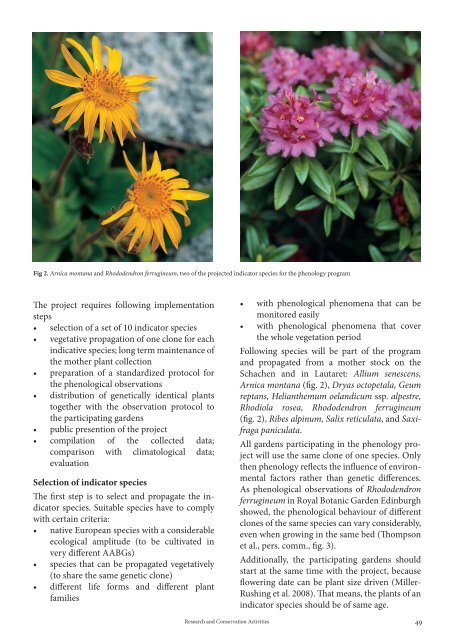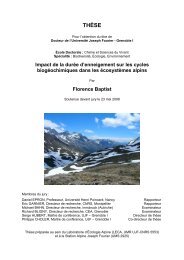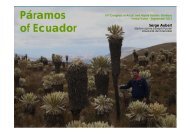2nd International Congress of Alpine and Arctic Botanical Gardens
2nd International Congress of Alpine and Arctic Botanical Gardens
2nd International Congress of Alpine and Arctic Botanical Gardens
Create successful ePaper yourself
Turn your PDF publications into a flip-book with our unique Google optimized e-Paper software.
Fig 2. Arnica montana <strong>and</strong> Rhododendron ferrugineum, two <strong>of</strong> the projected indicator species for the phenology program<br />
The project requires following implementation<br />
steps<br />
• selection <strong>of</strong> a set <strong>of</strong> 10 indicator species<br />
• vegetative propagation <strong>of</strong> one clone for each<br />
indicative species; long term maintenance <strong>of</strong><br />
the mother plant collection<br />
• preparation <strong>of</strong> a st<strong>and</strong>ardized protocol for<br />
the phenological observations<br />
• distribution <strong>of</strong> genetically identical plants<br />
together with the observation protocol to<br />
the participating gardens<br />
• public presention <strong>of</strong> the project<br />
• compilation <strong>of</strong> the collected data;<br />
comparison with climatological data;<br />
evaluation<br />
Selection <strong>of</strong> indicator species<br />
The first step is to select <strong>and</strong> propagate the indicator<br />
species. Suitable species have to comply<br />
with certain criteria:<br />
• native European species with a considerable<br />
ecological amplitude (to be cultivated in<br />
very different AABGs)<br />
• species that can be propagated vegetatively<br />
(to share the same genetic clone)<br />
• different life forms <strong>and</strong> different plant<br />
families<br />
• with phenological phenomena that can be<br />
monitored easily<br />
• with phenological phenomena that cover<br />
the whole vegetation period<br />
Following species will be part <strong>of</strong> the program<br />
<strong>and</strong> propagated from a mother stock on the<br />
Schachen <strong>and</strong> in Lautaret: Allium senescens,<br />
Arnica montana (fig. 2), Dryas octopetala, Geum<br />
reptans, Helianthemum oel<strong>and</strong>icum ssp. alpestre,<br />
Rhodiola rosea, Rhododendron ferrugineum<br />
(fig. 2), Ribes alpinum, Salix reticulata, <strong>and</strong> Saxifraga<br />
paniculata.<br />
All gardens participating in the phenology project<br />
will use the same clone <strong>of</strong> one species. Only<br />
then phenology reflects the influence <strong>of</strong> environmental<br />
factors rather than genetic differences.<br />
As phenological observations <strong>of</strong> Rhododendron<br />
ferrugineum in Royal Botanic Garden Edinburgh<br />
showed, the phenological behaviour <strong>of</strong> different<br />
clones <strong>of</strong> the same species can vary considerably,<br />
even when growing in the same bed (Thompson<br />
et al., pers. comm., fig. 3).<br />
Additionally, the participating gardens should<br />
start at the same time with the project, because<br />
flowering date can be plant size driven (Miller-<br />
Rushing et al. 2008). That means, the plants <strong>of</strong> an<br />
indicator species should be <strong>of</strong> same age.<br />
Research <strong>and</strong> Conservation Activities 49




